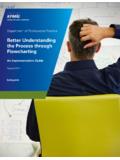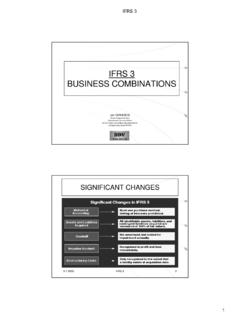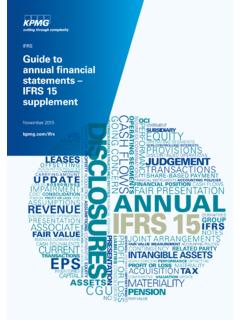Transcription of IFRS AND U.S. GAAP Issues In-Depth - execed.kpmg.com
1 ifrs AND GAAP. Issues In-Depth Revenue from Contracts with Customers September 2014. Contents A new global framework for revenue 1 Customer options for additional goods or services 144. 1 Key facts 2. Customers' unexercised rights (breakage) 147. 2 Key impacts 3 Nonrefundable up-front fees 149. Onerous contracts 152. 3 Putting the new standard into context 4. 11 Presentation 158. 4 Scope 8. In scope 8 12 Disclosure 162. Out of scope 9 Annual disclosure 162. Partially in scope 10 Interim disclosures 169. Portfolio approach 14 Disclosures for all other entities ( GAAP.)
2 Only) 170. 5 The model 16. Step 1: Identify the contract with a customer 16 13 Effective date and transition 172. Step 2: Identify the performance obligations in Effective date 172. the contract 22 Retrospective method 174. Step 3: Determine the transaction price 33 Cumulative effect method 180. Step 4: Allocate the transaction price to the First-time adoption ( ifrs only) 181. performance obligations in the contract 51. 14 Next steps 184. Step 5: Recognize revenue when or as the entity satisfies a performance obligation 65 Accounting and disclosure 185.
3 Tax 185. 6 Contract costs 95 Systems and processes 186. Costs of obtaining a contract 95 Internal control 186. Costs of fulfilling a contract 98 Determine a transition method 188. Amortization 102 Other considerations 189. Impairment 104. Detailed contents 191. 7 Contract modifications 106. Identifying a contract modification 106 Index of examples 194. Accounting for a contract modification 110 Guidance referenced in this publication 196. 8 Licensing 113 Keeping you informed 199. Licenses of intellectual property 114. Acknowledgments 201.
4 Determining whether a license is distinct 114. Determining the nature of a distinct license 119. Sales- or usage-based royalties 124. 9 Sale or transfer of nonfinancial assets that are not part of an entity's ordinary activities 127. General requirements 127. Application under ifrs 128. Application under GAAP 131. 10 Other Issues 135. Sale with a right of return 135. Warranties 137. Principal versus agent considerations 141. Issues In-Depth : Revenue from Contracts with Customers | 1. A new global framework for revenue In May 2014, the IASB and the FASB published their new joint standard on revenue recognition.
5 This replaces most of the guidance on revenue recognition that currently exists under ifrs and GAAP. The 2017 effective date might seem a long way off but already many companies are analyzing the implications for both external financial reporting and the core systems used to produce the numbers. Most companies are finding that they are impacted in some way, although the impacts vary widely depending on the nature of their business and how they contract with their customers. In this publication, we have pooled the insights and experience of our revenue recognition teams in the United States and globally to guide you through the requirements of the new standard.
6 We have illustrated the main points with examples and explained our emerging thinking on key interpretative Issues . We know that one of the first questions companies ask is how does this compare with my current accounting? and have included comparisons with current ifrs and GAAP requirements. Proud as we are to present this publication, we realize that it is a work in progress. Every day brings new questions and new insights, which we will share in future publications. Whether you are beginning your analysis of the new standard or deep into your implementation project, we hope this publication will help you move forward.
7 Brian K. Allen Phil Dowad Mark M. Bielstein Catherine Morley Prabhakar Kalavacherla (PK) Brian O'Donovan Paul H. Munter Thomas Schmid Department of Professional Practice, KPMG International Standards Group KPMG LLP, United States 2014 KPMG LLP, a Delaware limited liability partnership and the member firm of the KPMG network of independent member firms affiliated with KPMG International Cooperative, a Swiss entity. All rights reserved. 2014 KPMG IFRG Limited, a UK company, limited by guarantee. All rights reserved. Home 2 | Issues In-Depth : Revenue from Contracts with Customers 1 Key facts The new standard provides a framework that replaces existing revenue guidance in GAAP and ifrs .
8 It moves away from the industry- and transaction-specific requirements under GAAP, which are also used by some ifrs preparers in the absence of specific ifrs guidance. New qualitative and quantitative disclosure requirements aim to enable financial statement users to understand the nature, amount, timing, and uncertainty of revenue and cash flows arising from contracts with customers. Entities will apply a five-step model to determine when to recognize revenue, and at what amount. The model specifies that revenue should be recognized when (or as) an entity transfers control of goods or services to a customer at the amount to which the entity expects to be entitled.
9 Depending on whether certain criteria are met, revenue is recognized: over time, in a manner that best reflects the entity's performance; or at a point in time, when control of the goods or services is transferred to the customer. Step 1 Step 2 Step 3 Step 4 Step 5. Identify Determine Allocate Identify the performance the the Recognize contract obligations transaction transaction revenue price price The new standard provides application guidance on numerous related topics, including warranties and licenses. It also provides guidance on when to capitalize the costs of obtaining a contract and some costs of fulfilling a contract (specifically those that are not addressed in other relevant authoritative guidance , for inventory).
10 For some entities, there may be little change in the timing and amount of revenue recognized. However, arriving at this conclusion will require an understanding of the new model and an analysis of its application to particular transactions. In addition, all entities will be subject to extensive new disclosure requirements. The new standard is effective for annual periods beginning on or after January 1, 2017 for entities applying ifrs , and for annual periods beginning after December 15, 2016 for public business entities and certain not-for-profit entities applying Early adoption is permitted only under The impact of the new standard will vary by industry.



